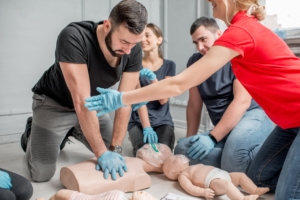Standard First Aid & CPR C: A Course Breakdown
When it comes to comprehensive first aid training, the Standard First Aid & CPR C course stands out as one of the most essential and widely recognized certifications. This Red Cross course is designed to equip participants with the knowledge and skills to handle a broad range of medical emergencies, making it a vital training for workplaces, schools, and individuals alike. Here’s a detailed breakdown of what the course entails and why it’s an important investment in safety.
What is Standard First Aid & CPR C?
Standard First Aid & CPR C is a comprehensive first aid training course offered by the Red Cross. It covers a wide array of first aid and CPR skills, providing participants with the confidence and competence to respond effectively in emergencies. This course is suitable for anyone who wants to be prepared for medical emergencies, whether at work, home, or in the community.
Course Content
In the Standard First Aid & CPR C course, participants will learn:
- Emergency Scene Management:
- Assessing and managing emergency scenes safely.
- Legal implications and the role of the first aider.
- CPR and AED Training:
- Adult, child, and infant CPR techniques.
- Proper use of an Automated External Defibrillator (AED).
- Airway and Breathing Emergencies:
- Management of choking for all age groups.
- Asthma and anaphylaxis protocols.
- Circulatory Emergencies:
- Heart attack, stroke, and severe bleeding management.
- Shock management.
- Wound Care:
- Treating minor and major wounds, including cuts, scrapes, and burns.
- Bandaging techniques and infection prevention.
- Injury Management:
- Fractures, sprains, and dislocations.
- Head, neck, and spinal injuries.
- Sudden Medical Emergencies:
- Diabetic emergencies, seizures, and poisoning.
- Environmental emergencies, such as heat and cold-related conditions.
- Secondary Survey:
- Conducting a thorough assessment and gathering medical history.
CSA Changes: Transition to Intermediate First Aid
In line with the latest Canadian Standards Association (CSA) guidelines, the Standard First Aid & CPR C course is undergoing a significant change. The updated standards aim to streamline first aid training across Canada, ensuring consistency and comprehensive coverage of essential skills. As part of these changes, Standard First Aid & CPR C is transitioning to Intermediate First Aid, replacing the Occupational First Aid (OFA) Level 2.
Key Changes Include:
- Updated Curriculum: Incorporates the latest best practices and medical guidelines.
- Extended Training: Includes more hands-on practice and scenario-based learning.
- National Standardization: Ensures consistency in first aid training across different provinces and territories.
Course Delivery Methods
We understand that everyone has different learning preferences and schedules. That’s why we offer the Standard First Aid & CPR C course in multiple formats to suit your needs:
- In-Person Training:
- Traditional classroom setting.
- Hands-on practice with real-time feedback from experienced instructors.
- Blended Learning:
- Combination of online and in-person training.
- Complete the theoretical components at your own pace online.
- Attend a shorter in-person session for practical skills and assessments.
Certification
Upon successful completion of the course, participants will receive a Standard First Aid & CPR C certification, valid for three years. This certification is recognized across Canada and meets the requirements for workplace safety regulations.
Why Choose Alert First Aid?
At Alert First Aid, we are committed to providing high-quality training that prepares you for real-life emergencies. Our experienced instructors and comprehensive course materials ensure that you receive the best education possible. Whether you choose in-person or blended learning, our courses are designed to be engaging, informative, and practical.
Ready to get certified? Register for a Standard First Aid & CPR C course today and take the first step towards comprehensive emergency preparedness.



